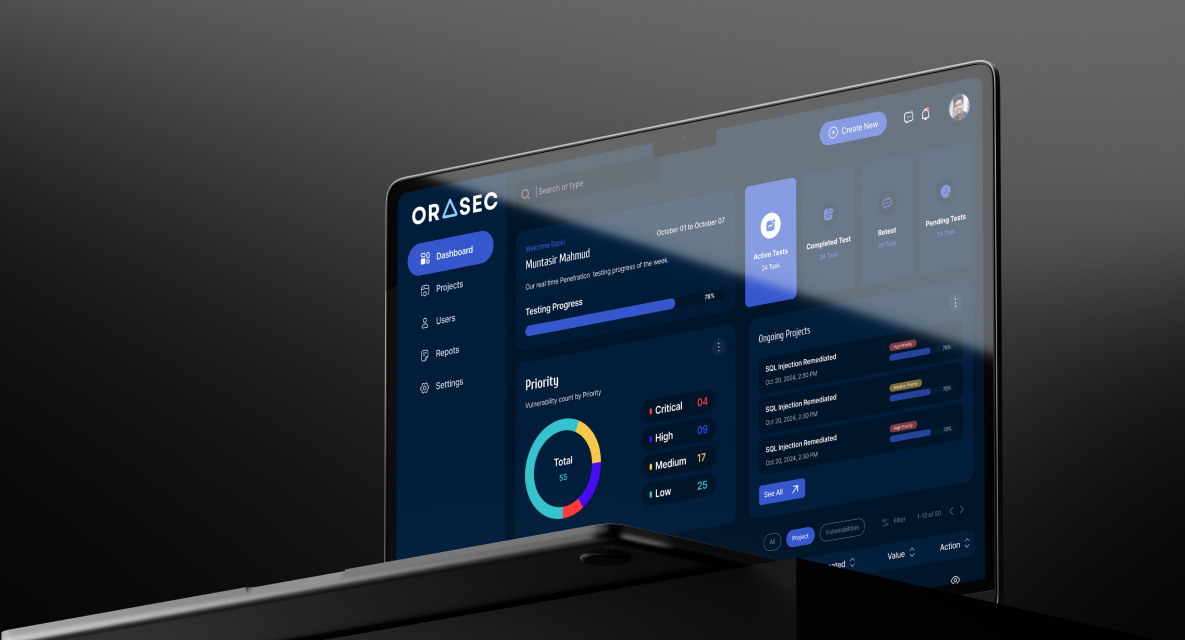In the fast-paced world of cybersecurity, organizations face the daunting task of managing vulnerabilities effectively. With increasing threats, having a robust platform for Penetration Testing as a Service (PTAAS) is essential. Our latest project focused on creating a UI/UX design that streamlines the vulnerability management process, catering specifically to pentesters, project managers, and admins.
The Importance of UI/UX in Vulnerability Management
User Interface (UI) and User Experience (UX) play critical roles in how users interact with complex systems. For a PTAAS platform, the design must not only be visually appealing but also functional and intuitive. A well-designed UI/UX can significantly improve task efficiency, user satisfaction, and overall productivity.
Key Challenges in Vulnerability Management
- Complexity of Data: Security teams often handle vast amounts of data related to vulnerabilities, making it crucial for the interface to simplify navigation and understanding.
- Collaboration Needs: Effective communication among team members about vulnerabilities is essential for quick resolution and action.
- Role-Specific Access: Different users require access to varying levels of information, making role-specific design vital for usability and security.
Tailoring the Experience for Different User Roles
To address these challenges, we began by identifying the unique needs of the platform’s primary users—Admins, Project Managers, and Pentesters. Each role has distinct responsibilities and information requirements, which guided our design decisions.
1. Role-Specific Dashboards
We created customized dashboards for each user role, allowing them to access relevant information quickly.
- Admins can view system-wide statistics, user activities, and security compliance metrics.
- Project Managers focus on project assignments, tracking progress, and team performance.
- Pentesters concentrate on vulnerability tasks, including active assessments and reports.
2. Streamlined Vulnerability Management
The core functionality of the PTAAS platform revolves around effective vulnerability management. We designed an intuitive interface that simplifies the processes of creating, updating, and tracking vulnerabilities.
Key Features:
-
Intuitive Input Forms: Users can easily record vulnerabilities through forms with essential fields such as CVSS scores, CWE, CVE, and impact severity. This facilitates accurate categorization and helps in efficient tracking of vulnerabilities.
-
Role-Based Access Control: By implementing specific access permissions, users can view only their assigned vulnerabilities. This not only enhances security but also minimizes information overload, allowing users to focus on their tasks.
-
Discussion Threads: Integrated discussion features enable users to engage in conversations related to specific vulnerabilities. This fosters collaboration and ensures that all team members are informed and involved in the resolution process.
3. Engaging Visual Design
The visual design of the PTAAS platform is both minimalist and engaging, ensuring that users can navigate the system effortlessly. Here are some design highlights:
-
Real-Time Data Displays: Dashboards feature interactive charts and key metrics that update in real time, allowing users to make informed decisions quickly.
-
Organized Layout: Tabs and sections neatly categorize different aspects of vulnerability management, such as details, discussions, and comments. This organization enhances the user experience by making information easy to find.
Outcome: A Comprehensive PTAAS Solution
The result is a powerful PTAAS platform that merges user needs with technical complexity, enhancing the overall vulnerability management experience. By prioritizing a seamless user experience, we’ve created a tool that empowers security professionals to work more efficiently and effectively.
Benefits of Effective UI/UX Design in Cybersecurity
- Increased Efficiency: A well-designed platform reduces the time spent navigating and managing vulnerabilities, allowing teams to focus on critical tasks.
- Improved Collaboration: Features like discussion threads facilitate better communication and collaboration among team members, leading to quicker resolutions.
- Enhanced User Satisfaction: A user-friendly interface ensures that users can accomplish their tasks with minimal friction, leading to higher satisfaction and adoption rates.
Let’s Collaborate!
We are excited about the successful implementation of this PTAAS platform UI/UX design and are eager to connect with other professionals and organizations in the cybersecurity field. If you have ideas for collaboration or projects in mind, we’d love to hear from you!
Contact us at:
📧 [email protected]
📞 WhatsApp: 01781907745
🌐 bertobaseit.com
This project demonstrates how thoughtful UI/UX design can elevate the effectiveness of vulnerability management in cybersecurity. By focusing on user needs and integrating essential features, we’ve created a platform that not only meets the demands of the industry but also empowers users to manage vulnerabilities with confidence. Stay tuned for more updates as we continue to innovate and improve our designs!


1 Comment
sefd